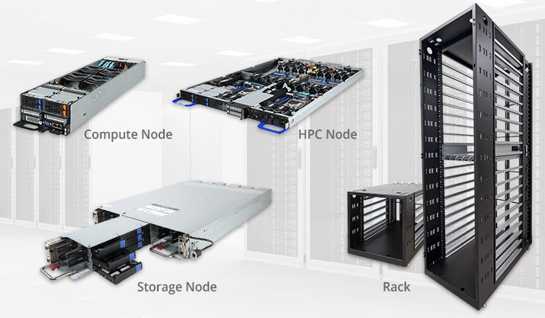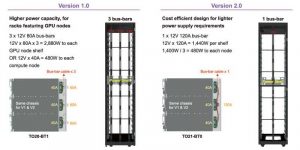Gigabyte TO22-Z61 and TO22-Z62 AMD EPYC Compute Nodes to Racklution-OP OCP Products
Features dual EPYC Naples processor sockets for compute nodes with high core counts and memory capacity, and offers storage options (all flash or mixed SATA/SAS+flash).
This is a Press Release edited by StorageNewsletter.com on January 23, 2019 at 2:20 pmGigabyte Technology Co., Ltd. announces availability of two AMD (Advanced Micro Devices, Inc.) EPYC compute nodes to its Racklution-OP product line, which is based on the Open Compute Project‘s (OCP) Open Rack Standards.
These two nodes, TO22-Z61 and TO22-Z62, feature dual EPYC Naples processor sockets for compute nodes with high core counts and memory capacity, and offer flexible storage options (all flash or mixed SATA/SAS+flash) and the availability of up to three additional PCIe expansion slots. Each node is designed to fit into a three bay, 20U tray. Not only available as a standalone product, the company can also combine and integrate these nodes into complete OCP compliant racks also available for deployment into your data center.
TO22-Z61 and TO22-Z62 compute nodes
TO22-Z61, TO22-Z62: EPYC compute nodes
These 20U height nodes feature dual AMD EPYC 7000 series (Naples) processor sockets, with eight channels of memory and 8xDIMM slots per socket (16xDIMM slots per node).
TO22-Z61 features a combination of flash and SATA storage capacity with 4×2.5″ frontal hot/swappable SSD/HDD drive bays that can feature maximum of two NVMe drives+two SATA drives (or up to 4xSATA drives instead of NVMe). SAS storage drives may also be utilized with an add-on card.
Meanwhile, TO22-Z62 offers a large capacity of all flash high performance all flash storage, with four 2.5″ frontal hot swappable drive bays that can feature maximum of four NVMe drives (or up to 4xSATA drives instead of NVMe), as well as adding further internal capacity with another 4xNVMe internal 2.5″ drive bays. (for a total capacity possible of eight 2.5″ NVMe drives).
TO22-Z61 and TO22-Z62 both feature two low profile PCIe x16 expansion slots for networking or storage expansion options. TO22-Z61 also has an additional OCP PCIe x16 mezzanine slot available (the OCP slot on TO22-Z62 is occupied by a U.2 HBA expander card). Networking wise, each node features dual 1GbE LAN ports, as well as a dedicated MLAN port for remote management.
Both TO22-Z61 and TO22-Z62 are designed to slide into the company’s 3-bay, 20U node trade (for a total density of three compute nodes per 20U rack height): either TO20-BT1 (an OCP Version 1.0 node tray compatible with the firm’s 41OU DO20-ST0 or DO20-ST1 racks or our 12OU DO60-MR0 mini-rack), or T021-BT0 (an OCP Version 2.0 node tray compatible with the firm’s 41OU DO21-ST0 or DO21-ST1 racks).
T020-BT1 OCP 1.0 node tray

T021-BT0 OCP 2.0 node tray
OCP server overview and benefits
What are the Open Rack Standards? They are a set of open source hardware design guidelines initially developed by Facebook, Inc. and then transformed in 2011 into an open source project. Being open source means that anyone can contribute, so a large number and variety of different organizations involved in building data centers have contributed their expertise and experience in designing hardware that is faster and easier to deploy, less expensive, and have the right features needed for scale and efficiency, with a design primarily geared around space and power savings.
The Open Rack Standards design can achieve this in several ways. Firstly, the rack width is 21″ compared with a traditional 19″ rack, with a server unit height of 10U (1.89” compared with the 1U height of 1.75″ for a traditional rack), allowing for more horizontal and vertical space in each tray for more compute, networking and storage density or for better airflow or cabling space. Secondly, the power supply for each server rackmount is removed and consolidated in a separate, central unit. This frees up more space for other components and also allows for better cooling and maintenance efficiency of the consolidated power supply unit. Power supply is instead supplied to compute, storage and GPU nodes directly through a ‘bus-bar’ system running along the rear of the rack.
In addition, the server nodes are designed like ‘Lego bricks’, which are small enough to be easily handled by a single person. This also adds to the design’s ease of scalability: each node is available individually and can be ordered later in time to add capacity to existing infrastructure. The Open Compute Project states that these design features were found to be 38% more energy efficient (*) to build and 24% less expensive to run (*) than traditional 19″ rack infrastructure for the first adopters of the Open Rack Standards.
Racklution-OP
Click to enlarge
Racklution-OP
The company’s Racklution-OP OCP rack solutions product line-up features two different power supply designs based on two different versions of the Open Rack Standards: OCP version 1.0 is a rack design that features power supply via three vertical 12V bus-bars, while OCP version 2.0 is a rack design where power is supplied via a single vertical 12V bus-bar only. Each bus-bar connector can directly supply up to 960W (80A x 12V), therefore an OCP Version 1.0 rack (three bus-bars) can supply up to 2,880W per shelf (960Wx3 bus-bar connectors), making it suitable for a rack with GPU nodes that have heavy power consumption requirements, while an OCP Version 2.0 rack (single bus-bar) can supply up to 480W per node, making it a cost efficient choice for compute and storage nodes where power requirements are not as heavy. Both versions co-exist with each other and customers can chose their design based on their specific system requirements.
Resource:
Racklution OP

















 Subscribe to our free daily newsletter
Subscribe to our free daily newsletter
